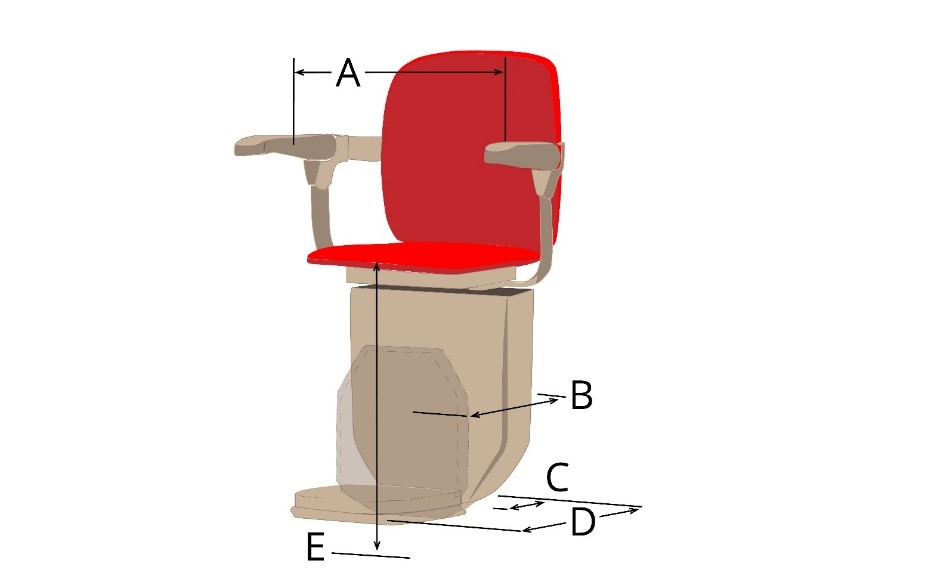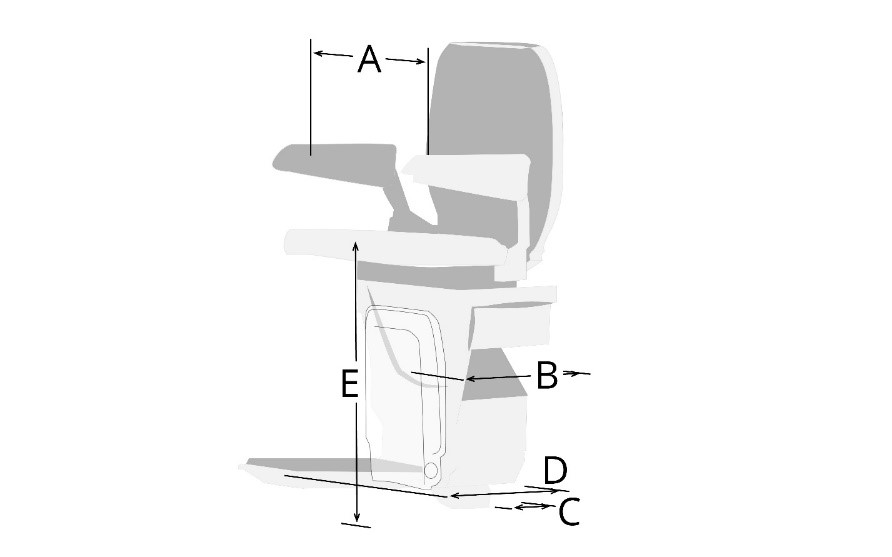Stairlift Dimensions & Specifications
Finding the Right Stairlift to Fit in Your Home
Chapters
For those considering a stairlift to address their mobility struggles, one of the most common concerns is how the stairlift will fit on their stairs and in their home. So, is a stairlift feasible? Let’s explore some stairlift dimensions and specifications to find out!
Stairlifts – A Practical Mobility Solution
Before we get started, let’s make sure we’re all on the same page. When we talk about stairlifts, we’re talking about a chair on a motorized chassis, riding along a metal rail that is fixed to the stair treads. These are not lift chairs, vertical platform lifts or home elevators. They cannot carry a wheelchair up the stairs, nor transport multiple riders at the same time. Stairlifts are designed for a single, seated user, bringing them up or down stairs with the gentle push of a button.
Types of Stairlifts and Where They Can be Installed
Stairlifts can be fitted onto straight, curved or outdoor staircases and come with a variety of options to suit the needs of the user. Straight stairlifts are mounted to a single, straight rail, cut to the precise length of the staircase, while Curved stairlifts are either modular or custom-made for the bends and turns of a curved or multi-flight staircase. Outdoor stairlifts are of a similar design, but weather-proofed to withstand the elements. Let’s take a look at some stairlift dimensions and specifications.
Stairlift Dimensions by Model
Stannah has a broad selection of stairlift models, offering different seat and rail types. For the purposes of this discussion, we’ll be looking at our most popular stairlift models, with standard features and options. Note: all dimensions shown are nominal.
Straight Stairlift Dimensions
- Chair Width (inside of armrests) = 20.5”
- Depth from Wall (Folded) = 14.5”
- Rail to Wall (Outside Edge of Rail) = 6”
- Depth from Wall (Unfolded) = 25.9″
- Seat Height (adjusted at installation) = 21.5” to 26.5”
Minimum Staircase Width = 28”

Model Shown: Siena 600
Curved Stairlift Dimensions
- Chair Width (inside of armrests) = 20.5”
- Depth from Wall (Folded) = 16” (depending on rail start position)
- Rail to Wall = 6” (will vary, depending on turns and configuration)
- Depth from Wall (Unfolded) = 26.7″ (may vary depending on configuration)
- Seat Height = 22.5”
Minimum Staircase Width = 28” – 30” (depending on configuration)

Model Shown: Siena 260
Outdoor Stairlift Dimensions
- Chair Width (inside of armrests) = 19”
- Depth from Wall (Folded) = 14.5”
- Rail to Wall (Outside Edge of Rail) = 8”
- Depth from Wall (Unfolded) = 25.25”
- Seat Height (adjustable for Straight) = 21.5” to 26.5”
Minimum Staircase Width = 26”

Model Shown: Outdoor 320
Stairlift Specifications & Requirements
Stairlift Maximum Weight Capacity
The weight capacity of a stairlift depends on the model you choose. Typically, straight stairlifts can carry up to 350 lbs, while curved and outdoor models have a weight limit of 300 lbs.
Stairlift Speed
Regardless of model, Stannah stairlifts all operate at 18 feet per minute. Taking you up and downstairs at a safe and steady pace.
Electrical Requirements
Whether straight or curved, indoor or outdoor, stairlifts run on battery power. The batteries are charged by a regular 110-Volt outlet, near the top or bottom of the stairs. In the case of an outdoor stairlift, you will still need access to an indoor outlet, nearby. The appropriate outlet is usually chosen during a free stair survey, so you don’t have to worry about that, until someone comes to see your stairs. If you’re concerned about your electric bill, don’t be. The stairlift uses about as much electricity as your coffee pot.
How wide do stairs have to be for a stair lift?
As mentioned above, minimum stair width depends on the model you choose and any obstructions on the staircase. Generally speaking, straight stairlifts require a 28” wide staircase, while curved stairlifts need around 30” (depending on the shape of your stairs). It is important to note that these measurements are from the furthest obstruction, meaning that handrails, moldings and other obstructions can reduce your staircase width. In some cases, handrails might need to be removed.
Rail Position
The position of a stairlift rail depends on the type of staircase you have and the model you choose. On most straight staircases, the outside edge of the rail is about 6” from the wall (or furthest obstruction). Rail-to-wall measurements for curved models will vary depending on the shape of your stairs and the turns it needs to make, but most straight sections are usually about 6” from the wall.
How do you measure for a stair lift?
Stairlift measurements are taken during a no-obligation stair survey, where a Stannah stairlift specialist will visit your home in order to determine which model and options you need.
Straight Stairlift Measurements
Straight stairs are measured for length and width, using a standard tape measure. Special care is taken to identify potential obstructions, such as a handrail or limited head clearance near the top of the stairs. Doors at the top landing or near the bottom are also taken into consideration, with the optional retractable rail providing a solution in most of these cases. The stairlift specialist will make sure that there is sufficient space for the chair to swivel at the top of the stairs, so you can get off safely.
Curved Stairlift Measurements
When measuring stairs that turn, Stannah’s stairlift specialists use a photo measuring system that utilizes markers on the stairs to develop accurate specs for the staircase. From there, the specialist will check the stairs for obstructions, just like they would for a straight unit, before sending the photos and a detailed drawing off to our rail designers. With their custom rails, curved stairlifts have the added benefit of offering a variety of starts and finishes to accommodate the specifics of your home. As a result, a curved stairlift can start around the corner from the stairs and continue onto the top landing, making it safer and easier to get on and off.
If you’d like to learn more about our measurement process, you can find additional information here.
Next Steps
Now that you have sense of some basic stairlift dimensions, it’s time to take things a step further. Check out our products pages for some more detailed information on our individual models. You can also learn about the stairlift buying process and how to get a free quote. Want even more detail? Check out our complete stairlift guide, which has everything you could ever want to know about stairlifts.
We understand that research is important and we want you to have all the information you need upfront. But, it’s natural to have questions and there’s no better way to get them answered than to talk to our helpful stairlift experts directly. We won’t pressure you or try to sell you something over the phone. Call us today for free, helpful advice, so you can make the best decision for you!

 USA
USA